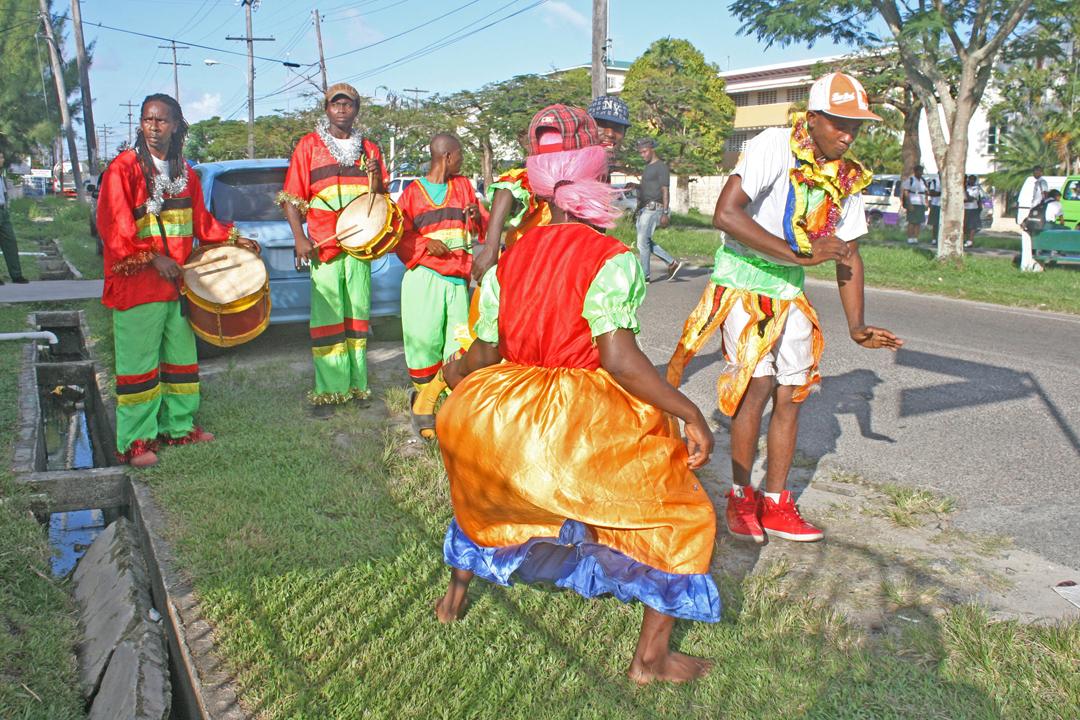 The festival of Christmas is usually celebrated or revered as sacred, but it is also a cultural phenomenon, particularly in the Caribbean, with history, sociology, structure and impact. Christmas, less popularly referred to as Yule or Yuletide, is overwhelmingly the largest, grandest and most popular festival celebrated or observed in all regions of the world. It is primarily a religious festival. It has all the characteristics known to large festivals which are observed by the world’s greatest religions. Included in these characteristics is that while the great religious festivals have outgrown their spiritual roots and functions, and might not superficially and popularly appear to be sacred, most of their manifestations generally proclaim the principles and beliefs of their religions.
The festival of Christmas is usually celebrated or revered as sacred, but it is also a cultural phenomenon, particularly in the Caribbean, with history, sociology, structure and impact. Christmas, less popularly referred to as Yule or Yuletide, is overwhelmingly the largest, grandest and most popular festival celebrated or observed in all regions of the world. It is primarily a religious festival. It has all the characteristics known to large festivals which are observed by the world’s greatest religions. Included in these characteristics is that while the great religious festivals have outgrown their spiritual roots and functions, and might not superficially and popularly appear to be sacred, most of their manifestations generally proclaim the principles and beliefs of their religions.
Large public festivals may be classified according to the nature of their activities and celebrations, their origins, functions, social place and impact. While Christmas was originally religious, it is less popularly celebrated as such around the world, and has grown to belong to several other categories. It is national, cultural, traditional, and commercial.
Christmas is one of the two most important observances sacred to the Christian religion as it celebrates the birth of Jesus Christ, worshipped by Christians as the son of God who came to earth as the Messiah, born of an earthly mother to live among humans for the salvation of mankind. The date of birth has been fixed as December 25, and is celebrated in church services, spiritual rituals and with several other practices both individual and public.
It is a national festival because it is the largest of all such public events in most countries that observe it. For these countries it is the most populous, celebrated by the entire population and officially sanctioned by the state. It is even multi-cultural, since members of other religions and unbelievers join in the celebration.
Christmas is a cultural festival because its celebrations, activities and observances include cultural traditions, several of which are associated with it. Particularly in western countries, this includes a period known as the Christmas Season (or Yuletide) with events throughout the month of December, reaching a peak on Christmas Day, and continuing into January. It is also cultural because of the widespread mythology that it has generated and the way of life adopted by societies during this season.
It is a traditional festival because it has deep roots and origins in old traditions, and has developed several traditions of its own, over its long period of existence. Christmas has overtaken a number of traditions belonging to pre-existing pagan festivals such as the Saturnalia and Roman culture, Germanic culture, the Jol of Norway and other Scandinavian conventions. Out of all of these, the surfeit of drinking, feasting and making merry has been a constant. Original Christmas traditions multiplied in the modern era when, as a cultural form, it developed its own mythology, secular beliefs and customs, such as Santa Claus.
It may also be described as a folk festival because the very origins of the Christmas story were located and identified among the folk. The circumstances of the miraculous birth were deliberately humble and strongly associated with shepherds. Many of the customs adopted by the evolving festival are folk traditions.
Christmas is by far the most popular festival in the world. Like all major religious festivals it has an extraordinarily effective public outreach that appeals to and commands the imagination of the populations of innumerable countries. It is the foremost cultural event for multicultural populations in the western world and attracts a cross-section of participants, many of whom have little interest in and slight understanding of the meaning of the birth of Christ. To underscore its impact, the festival has invaded several non-Christian and non-western cultures. No doubt, a prominent factor in this popular appeal is the revelry of drinking and feasting.
Christmas is unparalleled as the world’s greatest commercial festival. This means it provides opportunities, because of its appeal, its pervading culture and immeasurable popularity, for enterprise. Its boundless reach to millions of participants makes it a billion-dollar industry. Great wealth is generated by production, sales and services in music, motion pictures, literature, cards, gifts, food, drinks, decorations, and a variety of entertainments.
It is a period for excessive spending by the world’s populations.
Origins
Christmas has its origins in Rome between 336 AD and 350 AD, when the young Roman Catholic Church sought to create a festival to mark Christ’s birth, but did not manufacture a new event. Pope Julius I is credited with arriving at an approximate date, though this has not been confirmed. The Roman Emperor Constantine has also been named as contributing to the creation of Christmas Day. December 25 fell in the middle of the old festival of Saturnalia, celebrated by the Romans in honour of the god Saturn who was responsible for agriculture. It was a highly festive occasion with feasting and drinking and excessive revelry. It is believed that the priests took it over as an opportunity to curb or eradicate the riotous excesses and uninhibited revelry of the Saturnalia and convert it into a more refined feast for a noble cause. This, however, has been disputed. It is also believed that Christmas Day was declared a holiday for the first time in 529 AD.
The converted festival also incorporated other traditions from ancient beliefs, such as a spiritual wonder, if not worship, of evergreen plants because of their continued life in the coldest of winters. There are Christmas carols about the holly and the ivy which demonstrate spiritual reverence for those plants and their association with the nativity.
Jesus was born in winter, which was obviously a force to be reckoned with in the consciousness of the ancient Europeans, since it seems to have been a factor in Christmas celebrations as the festival evolved. Another root from which it developed was the Yule, an old Scandinavian and Germanic tradition also known as Jol and associated with the god Odin. Yule celebrated the Winter Solstice, the shortest day of the year, on December 21, with a season ending on January 1. The name Yule derives from the Anglo Saxon “geol”, as does the word Christmas which is from the Old English Cristes maesse, so that the festival became known as both Christmas and Yule. The season also consisted of a series of feast days sacred to the Roman Catholic Church, such as the Feast of Stephen (Boxing Day) and the Feast of the Epiphany (Twelfth Night).
The origins, history and evolution are complex with roots and influences found in the pagan festivals, the Roman, the Germanic, the Anglo Saxon, the Norse, the Middle English, and the church itself. The season officially begins on December 25, the First Day of Christmas, Christ’s birth, and ends on Twelfth Night, January 5 or 6, depending on how the days are counted, the Epiphany, when the three Wise Men, the Magi, presented the baby Jesus with gifts and he was declared to the world as the Messiah.
Religion, symbolism and myth
The story of the Nativity is narrated in the Holy Bible, the main text, particularly in the Four Gospels of the New Testament. Faith and belief are contained in the main plot as are major themes of rebirth and renewal, rejoicing and celebration, peace and goodwill to all men. These are specific in the religious messages, but what is fascinating is that even though the public outreach of the festival is dominated by the popular culture, merrymaking, revelry and commercialism, the symbolism, dramatisation and spectacle still significantly reflect the themes and principles of the faith.
Among the main customs at Christmas is the giving of gifts, which dominates the practice of families and friends. There is also the attendant mythology. Santa Claus is famous for the distribution of presents, mainly to children. According to the myth, he manages a toy factory with a labourforce of elves and covers the entire globe on Christmas Eve night, travelling in a sleigh pulled by flying reindeer.
The Santa Claus mythology is a magical world of fantasy born out of actual belief by Europeans in the existence of the superhuman creatures such as fairies and elves. But that world particularly appeals to children and happens to be in keeping with the religious theme and belief in the Christ child, complete with the miracle of his birth.
There is symbolism and spectacle in the Christmas decorations, the ubiquitous tableaux of the manger, the pastoralism, the star and the Christmas tree. Although it is far from the minds of the popular secular celebrants, the manger is symbolic of humility, the star is a survival of the original story of the Nativity, while the Christmas tree is another survival from ancient worship of the evergreen plants, but also of the extended imagery of everlasting life and renewal at the core of Christian belief.
Drama
Other dramatisations have come down from Mediaeval times, such as wassailing and other theatre. Wassailing involves the performance of carols by groups travelling around a community who are often rewarded with refreshments and drinks. There are also elements of folk theatre like mumming, pantomime and nativity plays. Mumming (sometimes mummery) is theatre: a folk form that takes place in communities, mostly part of rural village life. Small groups of amateurs disguise themselves in costumes and go around from house to house at Christmas time performing mini dramas to amuse the neighbours and partake in refreshments. The pantomime is more elaborate folk theatre with different types on the European continent and in England. The British form developed as a stage play performed at Christmas. The plot is normally based on a folk tale or fairy tale and it has particular theatrical characteristics.
Of these three traditional performances, the nativity play most directly reflects the Christmas theme. It is perhaps the oldest of these dramatic types, having been introduced in the church when priests developed the liturgies to teach the congregation about Christianity by committing Bible verses and stories to drama. One form of play that arose from this is the nativity play which tells the story of Jesus’ birth. The nativity survived to the present time and appears in amateur theatre at Christmas time.
Christmas in the Caribbean
Where the Caribbean region is concerned, the festival of Christmas was imported into the society as part of Christianity by the European colonists during plantation slavery. But over the centuries, while not changing its basic form, it has become creolised/indigenised so that it is no longer exclusive to the colonials and there is such a thing as a Caribbean Christmas in the local culture. Today, in different Caribbean territories, there are customs and traditions belonging to the culture of the various countries that are identified with Christmas. These include items of food and drink as well as secular ritualistic practices which vary from one nation to the other. These are sufficiently substantial to merit a study of local Christmas traditions.
Celebration was segregated during slavery. While the plantocracy observed the season with much partying among themselves, work ceased on the estates, allowing the enslaved to amuse themselves and to revive a number of African traditions. These had nothing to do with the nativity. Significantly, some of them were acts of resistance disguised as harmless frolic, and some were religious and spiritual.
Foremost among these are various forms of the masquerade tradition which reached their highest state of magnitude and grandeur in the Jamaican jonkonnu of the nineteenth century. Most of these forms have faded away, but they include the jonkonnu of Jamaica, and jonkanu of the Bahamas (now the strongest and most vibrant), the mummies of St Kitts, the Barbados tuk band, various forms in Trinidad and the masquerade in Guyana. These are or have been Christmas time performance traditions.
Interestingly, there is only one of these performance traditions in the entire Caribbean that celebrates the birth of Christ. That is the Parang of Trinidad. It is perhaps the strongest survivor of Spanish culture in the island – it is Christian and exhibits a Roman Catholic influence. Parang developed as a cultural form in a number of villages, particularly among cocoa producers. It is a music and dance tradition accompanied by customs, types of food and drinks. Songs are sung in Spanish predominantly celebrating the nativity and deifying the Virgin Mary – popularly addressed in the lyrics as “Maria”.
Parang bands used to go around at Christmas, much like the mumming and wassailing traditions, visiting households to entertain them and partake in refreshments. The celebrants had a culture of giving gifts and many of their songs are regarded as gifts and called aguinaldo. Parang has a clearly distinct sound and rhythm, very lively and musical with traditional instruments, particularly guitars and chac chacs. When the custom seemed to be waning, it was aggressively revived a number of years ago, and now parang bands appear every Christmas, performing on stage and making recordings.
There are several acts, customs and traditions in the Caribbean, both imported and evolved in the local societies to enrich the celebration. But apart from the parang, they do not, as a rule, celebrate the birth of Christ.









